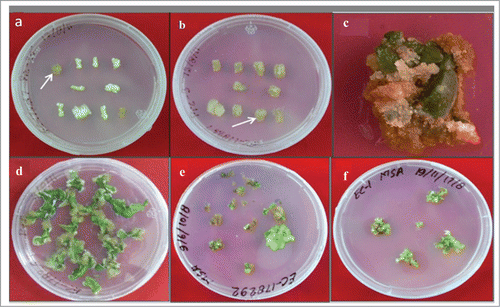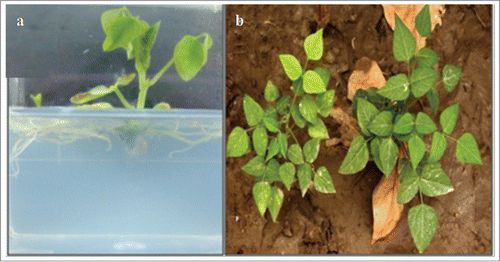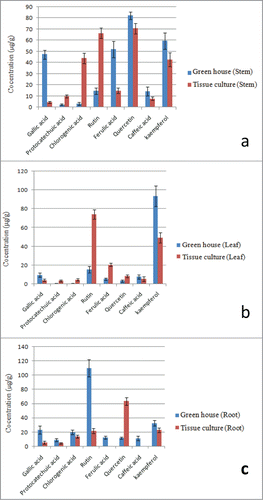Figures & data
Figure 1. Direct shoot regeneration from epicotyls and intermodal explants on medium containing TDZ. (A) Incubation of epicotyls explants on shoot induction medium containing AgNO3 to stop tissue browning; (B) Shoot induction from epicotyls explants; (C) Shoot induction from intermodal explants.

Table 1. Direct shoot regeneration from epicotyls and internodal segments of P. tetragonolobus. Effect of TDZ concentrations in shoot-induction media on regeneration efficiency
Table 2. Callus mediated shoot bud induction from cotyledon, leaf and hypocotyl explants of P. tetragonolobus, effect of BAP in combination with IAA or NAA concentrations on regeneration response
Figure 2. Callus mediated shoot bud induction and shoot regeneration form hypocotyls and cotyledon explants on media containing BAP and NAA or IAA. (A) and (B). Callus induction from hypocotyl explants on media containing various concentrations of plant growth regulators, callus with regeneration potential was indicated with arrow markings; (C) Callus produced from cotyledon explants; (D) Callus induction from leaf discs incubated BAP and NAA containing medium. (E) Shoot buds and shoots produced from the callus which was obtained from hypocotyls explants; (F) Incubation of shoots for further proliferation on shoot induction medium.

Table 3. Effect of BAP, NAA and IAA concentrations on morphology of the callus associated with regeneration response. Observations were made when hypocotyl segments were used as explants
Figure 3. Transfer of plants obtained from in vitro regenerated shoots of; (A) Rooting of isolated shoot on rooting media; (B) Transfer and survival plants in green house conditions, well rooted plants were transferred to plastic pots and acclimatized before transferring to soil.

Table 4. Contents of secondary metabolites in different parts of P. tetragonolobus plants from green house and tissue culture raised plants
Figure 4. Comparative analysis of polyphenolic compounds present in stem, leaf and roots of green house grown (labeled as green) and tissue culture raised (labeled as red) P. tetragonolobus plants; (A) Graph showing contents of poyphenolic compounds in Stems of both type of plants; (B) Graph showing contents of poyphenolic compounds in Leaves of both type of plants; (C) Graph showing contents of poyphenolic compounds in Roots of both type of plants. Graphs were plotted with concentrations of polyphenolic compounds (mg/g) on x-axis and various types of polyphenolic compounds on y-axis.

